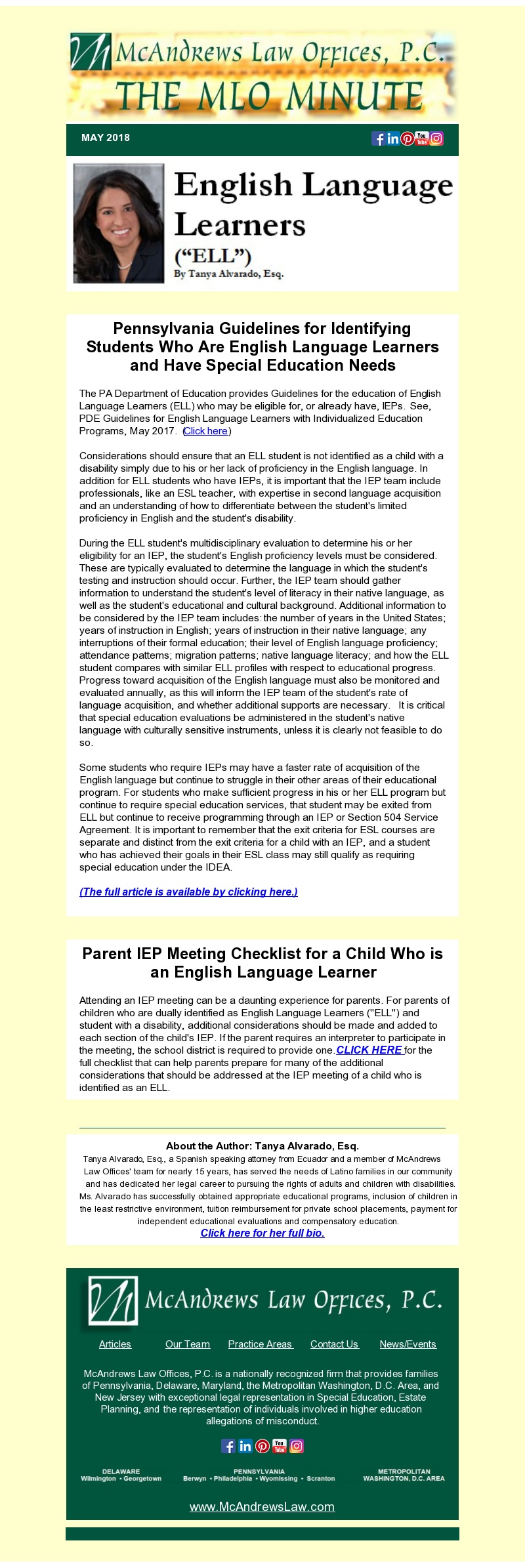April 2018
The MLO Minute: English Language Learners (“ELL”)
By Tanya Alvarado, Esq.
Pennsylvania Guidelines for Identifying Students Who Are English Language Learners and Have Special Education Needs
The PA Department of Education provides Guidelines for the education of English Language Learners (ELL) who may be eligible for, or already have, IEPs. See, PDE Guidelines for English Language Learners with Individualized Education Programs, May 2017. http://www.education.pa.gov/Documents/K-12/Special%20Education/Guidelines%20for%20English%20Learners%20with%20IEPs.pdf
Considerations should ensure that an ELL student is not identified as a child with a disability simply due to his or her lack of proficiency in the English language. In addition for ELL students who have IEPs, it is important that the IEP team include professionals, like an ESL teacher, with expertise in second language acquisition and an understanding of how to differentiate between the student’s limited proficiency in English and the student’s disability.
During the ELL student’s multidisciplinary evaluation to determine his or her eligibility for an IEP, the student’s English proficiency levels must be considered. These are typically evaluated to determine the language in which the student’s testing and instruction should occur. Further, the IEP team should gather information to understand the student’s level of literacy in their native language, as well as the student’s educational and cultural background. Additional information to be considered by the IEP team includes: the number of years in the United States; years of instruction in English; years of instruction in their native language; any interruptions of their formal education; their level of English language proficiency; attendance patterns; migration patterns; native language literacy; and how the ELL student compares with similar ELL profiles with respect to educational progress. Progress toward acquisition of the English language must also be monitored and evaluated annually, as this will inform the IEP team of the student’s rate of language acquisition, and whether additional supports are necessary. It is critical that special education evaluations be administered in the student’s native language with culturally sensitive instruments, unless it is clearly not feasible to do so.
Some students who require IEPs may have a faster rate of acquisition of the English language but continue to struggle in their other areas of their educational program. For students who make sufficient progress in his or her ELL program but continue to require special education services, that student may be exited from ELL but continue to receive programming through an IEP or Section 504 Service Agreement. It is important to remember that the exit criteria for ESL courses are separate and distinct from the exit criteria for a child with an IEP, and a student who has achieved their goals in their ESL class may still qualify as requiring special education under the IDEA.
(The full article is available by clicking here.)
Parent IEP Meeting Checklist for a Child Who is an English Language Learner
Attending an IEP meeting can be a daunting experience for parents. For parents of children who are dually identified as English Language Learners (“ELL”) and student with a disability, additional considerations should be made and added to each section of the child’s IEP. If the parent requires an interpreter to participate in the meeting, the school district is required to provide one. CLICK HERE for the full checklist that can help parents prepare for many of the additional considerations that should be addressed at the IEP meeting of a child who is identified as an ELL.





